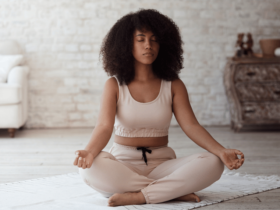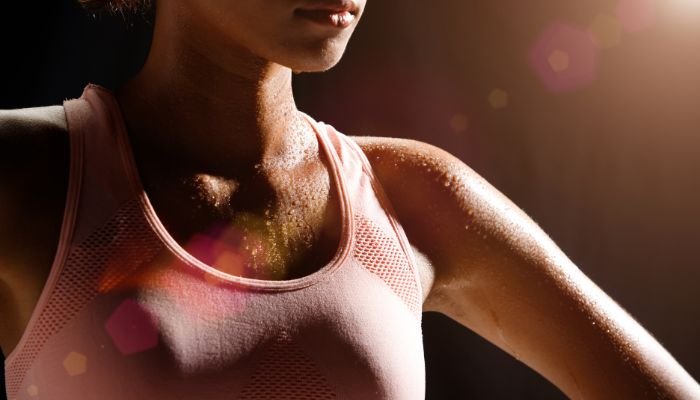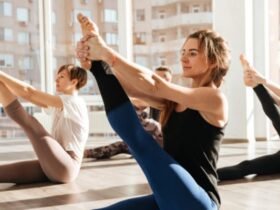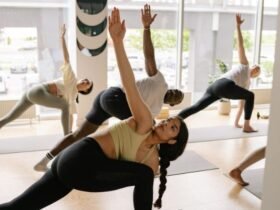Designing your personal yoga practice routine can be an empowering way to tailor your practice to your specific fitness goals, needs, and preferences.
By understanding your body’s limits and needs, you can create a personalized practice that helps you achieve greater flexibility, strength, and mental clarity while also managing stress. Here’s a step-by-step guide to help you design your own Sweat Yoga routine.
Set Your Intention and Goals
Before creating your Sweat Yoga practice, it’s important to define the goals you want to achieve. These goals will guide your practice and ensure that it aligns with your fitness needs. Ask yourself:
- Do you want to increase flexibility?
- Are you looking to build strength or endurance?
- Is stress reduction or mental clarity your primary goal?
- Do you need to focus on detoxification through sweating?
By setting a clear intention, you can structure your practice to work toward your desired outcomes.
Create a Warm-Up Routine
A proper warm-up is essential to prepare your body for the intense heat and physical exertion of Sweat Yoga.
Start with gentle stretches and movements to activate the muscles and joints, focusing on areas that tend to be tight or stiff, such as the hips, shoulders, and lower back.
Some great warm-up poses to include are:
- Cat-Cow Pose (Marjaryasana-Bitilasana): This helps loosen the spine and engage the core muscles.
- Downward Dog (Adho Mukha Svanasana): A great stretch for the hamstrings, calves, and back.
- Sun Salutations (Surya Namaskar): A flowing sequence that warms up the entire body.
A warm-up will also mentally prepare you for the intensity of the session by calming the mind and helping you focus.
Types of Sweat Yoga for Flexibility Strength and Mental Clarity
Design Your Main Sequence
The main part of your Sweat Yoga practice should be dynamic, involving a combination of standing poses, balance poses, backbends, and seated stretches.
Here are some tips for building a balanced and effective sequence:
Incorporate Strength-Building Poses
Since Sweat Yoga is about pushing your limits, incorporate poses that challenge your strength and endurance. Some effective poses for building strength include:
- Plank Pose (Phalakasana): Strengthens the core, arms, and shoulders.
- Warrior Poses (Virabhadrasana I, II, III): Builds strength in the legs and core.
- Chair Pose (Utkatasana): Strengthens the thighs and engages the glutes.
What is Sweat Yoga? Benefits and How It Works
Add Flexibility-Enhancing Poses
Flexibility is a key benefit of Sweat Yoga, and your sequence should include deep stretches to increase range of motion. Some flexibility-boosting poses include:
- Forward Fold (Uttanasana): A deep hamstring stretch that also calms the nervous system.
- Pigeon Pose (Eka Pada Rajakapotasana): Opens the hips and stretches the glutes and lower back.
- Cobra Pose (Bhujangasana): A backbend that stretches the spine and opens the chest.
Balance and Stability
Incorporating balance poses will help improve your coordination and stability while also building mental focus. Some good options are:
- Tree Pose (Vrksasana): Strengthens the legs and improves balance.
- Warrior III (Virabhadrasana III): A challenging balance pose that engages the core and legs.
- Half Moon Pose (Ardha Chandrasana): A dynamic pose that strengthens the legs and improves balance.
How Often Should You Practice Sweat Yoga?
Focus on Breathwork
Breathwork is essential in Sweat Yoga to keep you grounded and prevent burnout. Inhale and exhale deeply to maintain your energy and rhythm. You may also consider incorporating specific breath patterns to enhance your practice:
- Ujjayi Breathing (Victorious Breath): Inhale and exhale through your nose with a slight constriction in the back of your throat, creating a soft “ocean” sound. This technique helps increase heat in the body and calms the mind.
- Nadi Shodhana (Alternate Nostril Breathing): A great breathing technique for balancing energy and calming the nervous system, especially after an intense sequence.
Incorporate Cooling Poses
Since Sweat Yoga is an intense and heated practice, it’s important to balance the heat with cooling poses. After your main sequence, include some restorative poses to help lower your heart rate and cool down the body:
- Child’s Pose (Balasana): A gentle resting pose that helps stretch the back and calm the nervous system.
- Seated Forward Fold (Paschimottanasana): A relaxing stretch for the hamstrings and lower back.
- Reclining Butterfly Pose (Supta Baddha Konasana): Opens the hips and relaxes the body, encouraging deep breathing.
These cooling poses help your body transition back to a calm state and promote relaxation.
Include a Savasana (Final Relaxation)
End your personal yoga practice with Savasana (Corpse Pose), which allows your body to fully relax and absorb the benefits of the practice.
Take a few minutes to lie down in a comfortable position, close your eyes, and focus on your breath. This final relaxation period helps reduce stress and anxiety, bringing you back to a state of mental clarity.
Listen to Your Body
Remember that designing your personal Sweat Yoga practice is a flexible process. Always listen to your body and make modifications when needed.
If a particular pose doesn’t feel right, feel free to skip it or adjust it to suit your level. It’s important to avoid pushing yourself too hard, especially in a heated environment, so stay mindful of your energy levels and take breaks if necessary.
Designing your own Sweat Yoga practice allows you to tailor the experience to your specific needs, goals, and fitness level.
Start with a solid warm-up, include strength-building and flexibility-enhancing poses, and focus on breathwork and cooling poses to create a balanced and effective routine.
Most importantly, listen to your body and practice with mindfulness, making adjustments as needed. By crafting your own personal Sweat Yoga session, you can enjoy the many physical and mental benefits of yoga while staying stress-free and energized.















Leave a Reply
View Comments